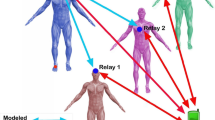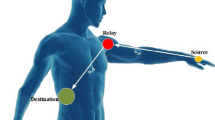Abstract
The problem of interference cancellation may arise in the nearest future for body-area networks (BANs) whenever a certain number of BANs are led to operate in the vicinity of each other under the same spectrum band. In this paper, using the data obtained from the measurements, the performance in terms of bit error rate (BER) of three linear CDMA receiver structures is investigated for BANs: the conventional receiver, the minimum mean square error receiver, and the decorrelator receiver. We show that in synchronous scenario, the three receivers exhibit the same performance regardless of the number of supported users and SNR level. The BER performance of the linear receivers in on-body channels is better than in Rayleigh channel with the belt-chest channel exhibiting the best gain due to the presence of a stronger LOS component. Furthermore, with orthogonal codes, these receivers are shown to be robust to the MAI level increase and do not require a perfect power control.










Similar content being viewed by others
References
P. S. Hall and Y. Hao, Antennas and Propagation for Body-Centric Wireless Communications, Artech HouseLondon, 2006.
P. S. Hall, et al., Antennas and propagation for on-body communication systems, IEEE Antennas and Propagation Magazine, Vol. 49, No. 3, pp. 41–58, 2006.
Y. Zhao, Y. Hao, A. Alomainy and C. Parini, UWB on-body radio channel modeling using ray theory and subband FDTD method, IEEE Transactions on Microwave Theory and Techniques, Vol. 54, No. 4, pp. 1827–1835, 2006.
A. Alomainy, Y. Hao, A. Owadally, C. Parini, Y. Nechayev, P. Hall and C. C. Constantinou, Statistical analysis and performance evaluation for on-body radio propagation with microstrip patch antennas, IEEE Transactions on Antennas and Propagation, Vol. 55, pp. 245–248, 2007.
Y. Hao, A. Alomainy, Y. Zhao, C. G. Parini, Y. Nechayev, P. Hall, and C. C. Constantinou, Statistical and deterministic modelling of radio propagation channels in WBAN at 2.45 GHz, In International Symposium IEEE Antennas and Propagation Society, ON, USA, pp. 2169–2172, 2006.
A. Fort, C. Desset, P. Wamacq, L. V. Biesen, Indoor body-area channel model for narrowband communications, IET Microwaves, Antennas and Propagations, Vol. 1, No. 6, pp. 1197–1203, 2007.
K. Ghanem and P. S. Hall, Interference cancellation using CDMA multi-user detectors for on-body channels, IEEE PIMRC, 2009 (accepted).
A. Duel-Hallen, J. Holtzman and Z. Zvonar, Multiuser detection for CDMA systems, IEEE Personal Communications Magazine, Vol. 2, pp. 46–58, 1995.
S. Moshavi, Multi-user detection for DS-CDMA communications, IEEE Communications Magazine, Vol. 34, pp. 124–137, 1996.
S. Verdu, Multiuser Detection, Cambridge University PressCambridge, 1998.
R. M. Buehrer, N. S. C-Mendoza and B. D. Woerner, A simulation comparison of multiuser receivers for cellular CDMA, IEEE Transactions on Vehicular Technology, Vol. 49, pp. 1065–1085, 2000.
C. Braun, M. Nilsson, R. D. Murch, Measurement of the interference rejection capability of smart antennas on mobile telephones, IEEE Vehicular Technology Conference, pp. 1068–1073, 1999.
J. Karlsson and J. Heinegard, Interference Rejection combining for GSM. In Proceedings of 5th IEEE International Conference on Universal Personal Communications, pp. 433–437, 1996.
M. L. McCloud, L. Scharf, M. K. Varanasi, Beamforming, diversity, and interference rejection for multiuser communication over fading channels with a receiver antenna array, IEEE Transactions on Communications, Vol. 51, No. 1, pp. 116–124, 2003.
E. Tiirola and J. Ylitalo, Performance of smart antenna receivers in WCDMA uplink with spatially coloured interference, IST Mobile Communications Summit 2001Barcelona, Spain, 2001. pp. 9–12.
A.A. Serra, A. Guraliuc, P. Nepa, G. Manara, and I. Khan, Diversity gain measurements for body-centric communication systems, International Journal Of Microwave And Optical Technology, Vol. 3, No. 3, pp. 283–289, 2008.
I. Khan, Y. Nechayev, K. Ghanem, and P. S. Hall, BAN–BAN interference rejection with multiple antennas at the receiver, IEEE Transactions on Antennas and Propagation (accepted).
E. Tiirola and J. Ylitalo, Performance of Smart Antenna Receivers in WCDMA Uplink with Spatially Coloured Interference, IST Mobile Communications SummitBarcelona, Spain, 2001. pp. 9–12.
D. Bladsjo, A. Furuskar, S. Javerbring, and E. Larsson, Interference cancellation using antenna diversity for EDGE-enhanced data rates in GSM and TDMA/136, In Proceedings of the 50th IEEE Vehicular Technology Conference, pp. 1956–1960, Fall 1999.
J. H. Winters, Optimum combining in digital mobile radio with co-channel interference, IEEE Journal on Selected Areas in Communications, Vol. SAC-2, No. 4, pp. 144–155, July, 1984.
R. T. Compton, Adaptive Antennas, concepts and performance, Prentice-Hall IncNew Jersey, USA, 1988.
I. Khan, P. S. Hall, Multiple antenna reception at 5.8 and 10 GHz for body-centric wireless communication channels, IEEE Transactions on Antennas and Propagation, Vol. 57, No.1, pp. 248–255, 2009.
I. Khan, P. S. Hall, A. A Serra, A. R. Guraliuc, and P. Nepa, Diversity performance analysis for on-body communication channels at 2.45 GHz, IEEE Transactions on Antennas and Propagation; special issue on “Antennas and Propagation for Body-Centric wireless Communications”, 2009 (accepted).
R. Lupas and S. Verdu, Near-far resistance of multiuser detectors in asynchronous channels, IEEE Transactions on Communications, Vol. 38, pp. 496–508, 1990.
Z. Xie, C. K. Rushforth, and R. T. Short, Multiuser signal detection using sequential decoding, IEEE Transactions on Communications, Vol. 38, pp. 578–583, 1990.
Author information
Authors and Affiliations
Corresponding author
Rights and permissions
About this article
Cite this article
Ghanem, K., Hall, P.S. & Langley, R. Interference Cancellation in Body-Area Networks Using Linear Multiuser Receivers. Int J Wireless Inf Networks 17, 126–136 (2010). https://doi.org/10.1007/s10776-010-0128-7
Received:
Accepted:
Published:
Issue Date:
DOI: https://doi.org/10.1007/s10776-010-0128-7




